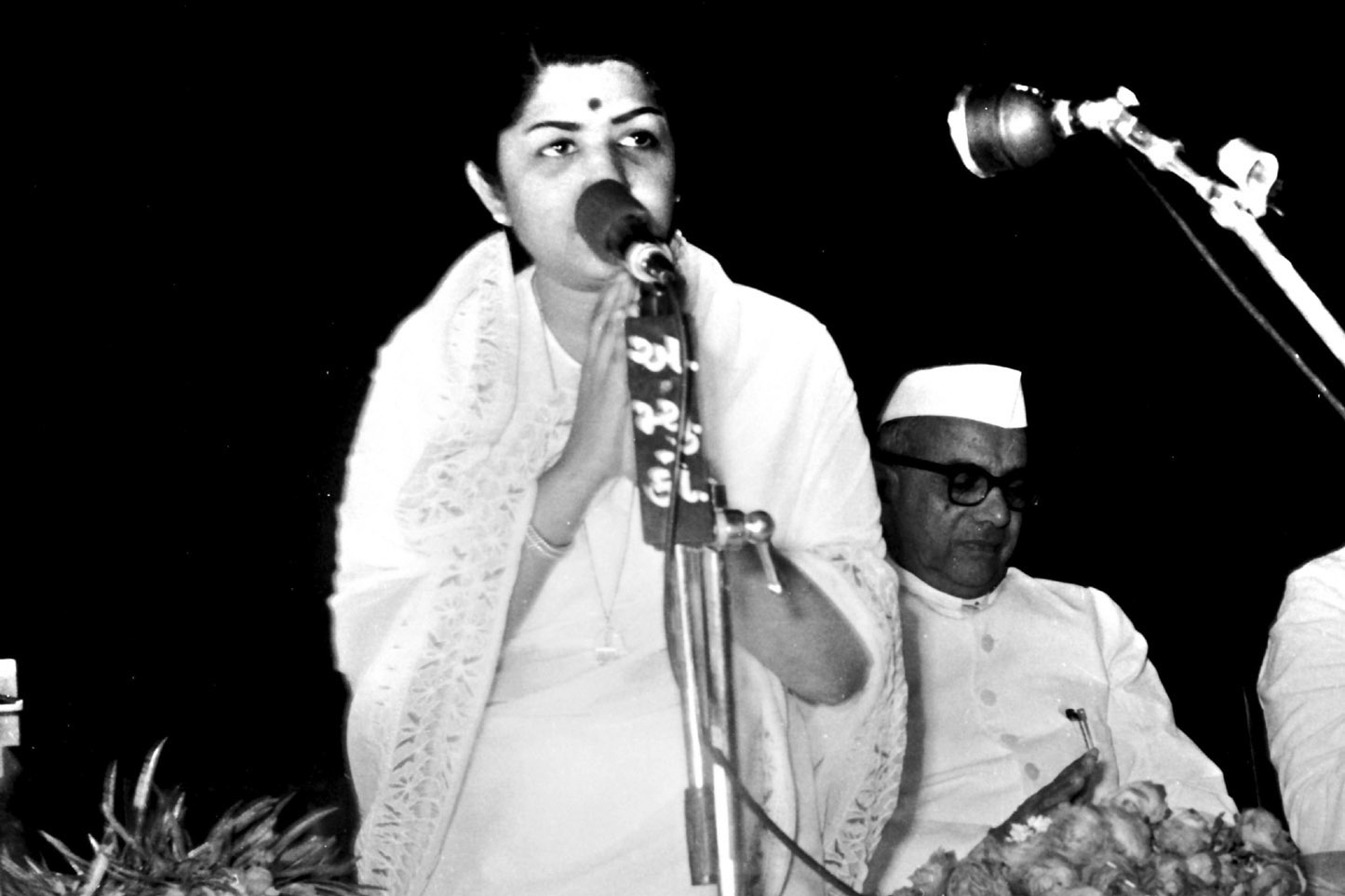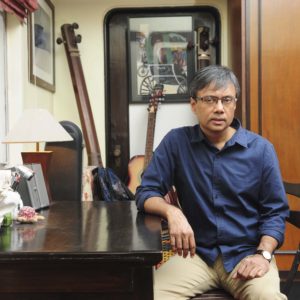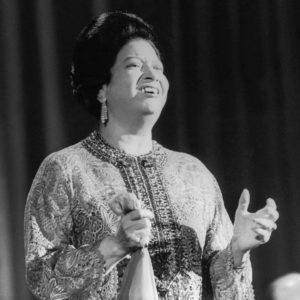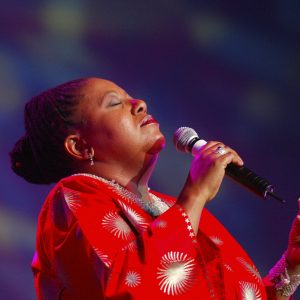Lata Mangeshkar, Bollywood’s iconic soprano
Often feted as an Indian cultural icon, the singer embodied the art of playback singing in Hindi cinema. But her legacy is also marred by her pro-Hindutva beliefs.
Author:
11 February 2022

“For the very heart of India throbs in your voice.” These lines of adulation by renowned Indian poet Naushad Ali eloquently exemplify singer Lata Mangeshkar’s iconic status as the “Nightingale of India”. Her exquisitely high harmonic vocal, with its ethereal smoothness, is hailed as idealised female singing in India, and a hallmark vocal style that continues to embody the art of playback music in Hindi cinema.
Lata Mangeshkar (or Lata Didi, “big sister”, as she was fondly called) lent her voice to some of the most iconic songs of love, longing, devotion and patriotism. She is said to have sung over 30 000 songs across genres and in over three dozen languages, including Hindi, Marathi, Bengali and Tamil.
The famed vocalist’s death on 6 February at the age of 92 ends an extraordinary musical career that spanned more than 70 years. Mangeshkar died at Mumbai’s Breach Candy Hospital where she was being treated for pneumonia and Covid-19 since early January. Her sister Usha Mangeshkar announced the death.
Mangeshkar’s death elicited profound sadness and an outpouring of tributes from across the world. Film-industry celebrities, politicians, sports personalities and writers all expressed their sorrow. The Indian government also declared two days of national mourning and accorded her a state funeral.
Related article:
“I am anguished beyond words. The kind and caring Lata Didi has left us. She leaves a void in our nation that cannot be filled,” Indian Prime Minister Narendra Modi tweeted, adding that the coming generations would remember her as a stalwart of Indian culture, “whose melodious voice had an unparalleled ability to mesmerise people.”
Pakistan Prime Minister Imran Khan also paid homage to the singer, remarking that the subcontinent has lost one of the world’s truly great singers. The Prime Minister of Bangladesh Sheikh Hasina added his voice too, saying Mangeshkar’s death has created a “great void in the subcontinent’s musical arena”, while Nepal’s President Bidya Devi Bhandari recalled the contribution of the “genius” singer to Nepali songs.
Over the decades, her voice became synonymous with Hindi cinema. It became positioned as the undisputed authority on the feminine ideal and, consequently, that ideal became entrenched in Indian nationalism. Mangeshkar’s persona as a national icon – specifically her image as medieval Hindu mystic singer Meera – became intertwined with the process of purifying, or Hinduising, the figure of the “ideal” Indian woman – one whose sexual conduct is both suggested and contained.
An illustrious career
Mangeshkar was born in 1929 at Indore in the state of Maharashtra, to a Marathi theatre artist and musician Deenanath Mageshkar. She was the oldest of five children and began her training at the age of five. Both she and her sister Asha Bhosle were taught music by several accomplished musicians.
The classically trained singer frequently sang in plays with her father, and performed with him on the radio when she was 11. After her father died, Mangeshkar, who was 13 at the time, began acting in Marathi films to support the family. She sang a few lines in a song featured in Gajabhau (1943). This was one of four films in which her voice featured that year.
She went on to become a household name after the country’s top music directors in the Hindi film industry invited her to sing in many of the movies produced in the late 1940s. Her first Hindi song was Paa lagoon kar jori for Vasant Joglekar’s Aap Ki Seva Mein (1946). Two years later, composer Ghulam Haider gave Mangeshkar her first major break with the song Dil mera toda in Majboor (1948).
After her hit Uthaye ja unke sitam in Andaz (1949), she went on to record Aayega Aanewala for Kamal Amrohi’s Mahal (1949).
This song is more associated with Mangeshkar’s star image than with the character played by iconic Indian actress Madhubala. Its initial recording identified the narrative character as the vocalist, but it became so popular that the radio stations were flooded with requests to play it, along with a demand to announce the name of the vocalist. As Mangeshkar’s name began to be broadcast, a shift began. In no time, “ghost” voices became recognised superstars.
Related article:
Her popularity soared after the release of Pyar Kiya to Darna Kya for the blockbuster movie Mughal e Azam (1960). The demand for Mangeshkar’s voice only grew after that and so did her fan base – year after year and generation after generation. The playback singer’s song Ae Mere Watan Ke Logo released as part of a film shortly after the Sino-Indian war in 1962 is widely revered and considered one of the country’s most patriotic songs.
Mangeshkar was active from the 70s up to the 21st century, lending her voice in many prominent films. Her last full film album was made for the Hindi-language period film Veer-Zaara in 2004.
The artist was the first Indian to perform at London’s Royal Albert Hall in 1974. And, in 1999, she was awarded the Padma Vibhushan, one of India’s highest civilian honours. Two years later, she became only the second film celebrity after director Satyajit Ray (1992) to receive the Bharat Ratna (2001), India’s highest civilian award.
Mangeshkar was the first playback singer to fight for a share in the royalties of film songs, instead of a flat fee for each song. This led to a much-publicised dispute with renowned singer Mohammed Rafi, who vowed not to sing with her for giving precedence to money over art.
The standard for hidden voices
Since the mid-1940s, songs in Hindi films have been sung by so-called playback singers who pre-record song sequences that actors then lip-synch during production. Until the early 1990s, Bollywood’s playback singing was dominated by a small number of vocalists.
There were several playback singers who were men and not many who were women. In fact, for a long time before the 90s, it was Mangeshkar’s voice that actors lip-synched. Many female singers emerged in the mid-1990s, but even they found it impossible to survive if their voice did not match with Mangeshkar’s.
In her 2010 book, Wanted Cultured Ladies Only! Female Stardom and Cinema in India, 1930s-1950s, film historian Neepa Majumdar notes that the shift to the dominance of a few recognisable voices in the Hindi film industry was engineered by “shrewd individuals” such as Mangeshkar, who were able to take advantage of the migration of popular stalwart singers such as Shamshad Begum and Noor Jehan to Pakistan after the partition of British India in 1947.
Majumdar concludes that, over time, the voice of Mangeshkar easily lent itself to appropriation as the norm of “ideal femininity”, while that of her sister Asha became associated with “oozing sensuality” and slotted only for the cabaret and disco numbers. This, it is believed, was one of the reasons the two sisters had a fractured relationship.
Mangeshkar had an exceptional ability to deliver difficult vocal melodies, typically pitched at high scales. This high-pitched female voice is consistent with the image of the ideal Indian woman that was prevalent during the 1950s and 60s.

As Majumdar further notes, in classical music, the respectable voice was shaped in the context of the emergence of upper-class women in vocal public performance where the natural voice and the chaste female body were linked. “In this context, one can read Lata’s monopoly in terms of the ‘clean’ lines of her thin, higher pitched voice replacing other voices, such as those of Noor Jehan and Shamshad Begum, who had a greater density and lower pitch to their voices,” she underlines.
Sanjay Srivastava, in a 2004 article, argued that Mangeshkar’s dominance cemented her as an aesthetic marker of the “modern” Indian female identity. Thus, in the process of nation building after independence, her voice and persona signified a traditional purity that transcended the female body on the screen and united the imagination of the Indian nation.
“To me, and I believe to every Indian, Lata Mangeshkar is not so much a person as a voice – a voice that soars high and casts a magic spell over the hearts of millions of Indians from the Himalayas to Kanyakumari,” wrote Gangadhar Gadgil in a 1967 piece commemorating the 25th anniversary of Mangeshkar’s career.
Right-wing ties
While Mangeshkar was adored across cultures, ethnicities and borders for her stunning musical renditions, some of her political views have often been polarising.
She was, for example, a lifelong admirer of radical right-wing Hindutva ideologue Veer Savarkar with whom she reportedly had familial ties. In an interview with national broadcaster Doordarshan, Mangeshkar said she referred to Savarkar as “Tatya”, a term used in deference to an elderly male relation. She had also lent her voice to some of the Marathi poems written by the controversial figure.
In 2021, she tweeted: “Namaste. Today is the birth anniversary of Veer Savarkar ji, a true son of Mother India, a freedom fighter, and a father-like figure. I bow down to him.”
Related article:
She also shared a close association with India’s right-wing Hindu nationalist Rashtriya Swayamsevak Sangh, the ideological parent of the Bharatiya Janata Party. She was also close to a number of this party’s leaders, especially Atal Bihari Vajpayee, L K Advani and Narendra Modi. And was reportedly close to Bal Thackeray – the founder of Hindu right-wing party Shiv Sena.
Mangeshkar’s song, Ram Naam Mein Jaadu Aisa, Ram Naam Man Bhaaye, became a signature tune of the BJP’s Rath Yatra, a political and religious rally that lasted from September to October 1990 which, among other things, triggered anti-Muslim violence in the country.



